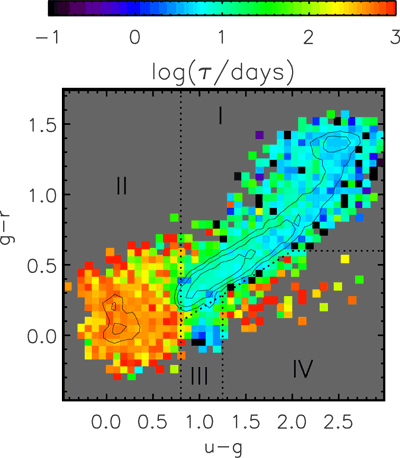
The median characteristic timescale τ for all variable point sources in S82 that are well described by the damped random walk model, as a function of u − g and g − r, following the legend at the top. The contours show regions containing 25%, 50%, and 75% of the total number of data points. The red regions with large τ coincide with the quasar color regions, providing a convenient method for quasar selection based on variability. For more details, see paper MacLeod et al. (2011). |
Despite all the interesting features in the nearby Universe, from our solar system to the Milky Way, there is much more to be learned by looking further. Although stars in distant galaxies often blur into a tiny blob of light, these blobs allow us to test our understanding of galaxy formation and evolution in many novel ways and to perform cosmological measurements.
Biased in part by my studies of stars, I am interested in the behavior of galaxies and quasars when observed across the entire electromagnetic spectrum. I am especially fond of quasars because they are such a unique probe of so many aspects of our astrophysical understanding. My quasar work falls in three broad categories: modeling of infrared dust emission, studies of their radio emission, and of their variability. Representative studies include clumpy dust model by Nenkova, Ivezić, & Elitzur (2002), a comprehensive analysis of extragalactic radio sources by Ivezić et al. (2002) and by Kimball & Ivezić (2008), and an application of the damped random walk model to describe quasar variability by MacLeod et al. (2010).
Chelsea's (MacLeod) work provided basis for an education and public outreach project by undergraduate students, described here.
|



































